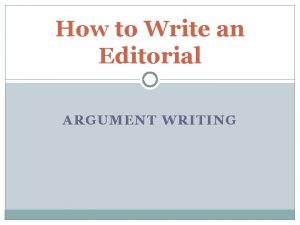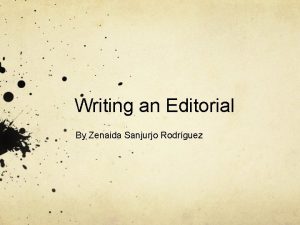How to Write an Editorial ARGUMENT WRITING Editorials





- Slides: 5

How to Write an Editorial ARGUMENT WRITING

Editorials have: 1. Introduction, body and conclusion like other news stories 2. An objective explanation of the issue, especially complex issues 3. A timely news angle 4. Opinions from the opposing viewpoint that refute directly the same issues the writer addresses 5. The opinions of the writer delivered in a professional manner. Good editorials engage issues, not personalities and refrain from name-calling or other petty tactics of persuasion. 6. Alternative solutions to the problem or issue being criticized. Anyone can gripe about a problem, but a good editorial should take a pro-active approach to making the situation better by using constructive criticism and giving solutions. 7. A solid and concise conclusion that powerfully summarizes the writer's opinion. Give it some punch.

Persuade �Editorials of persuasion aim to immediately see the solution, not the problem. From the first paragraph, readers will be encouraged to take a specific, positive action. Political endorsements are good examples of editorials of persuasion.

Writing an editorial 1. Pick a significant topic that has a current news angle and would interest readers. 2. Collect information and facts; include objective reporting; do research 3. State your opinion briefly in the fashion of a thesis statement 4. Explain the issue objectively as a reporter would and tell why this situation is important 5. Give opposing viewpoint first with its quotations and facts

Writing an editorial continued… 6. Refute (reject) the other side and develop your case using facts, details, figures, quotations. Pick apart the other side's logic. 7. Concede a point of the opposition — they must have some good points you can acknowledge that would make you look rational. 8. Repeat key phrases to reinforce an idea into the reader's minds. 9. Give a realistic solution(s) to the problem that goes beyond common knowledge. Encourage critical thinking and pro-active reaction. 10. Wrap it up in a concluding punch that restates your opening remark (thesis statement). 11. Keep it to 500 words; make every work count; never use "I"









